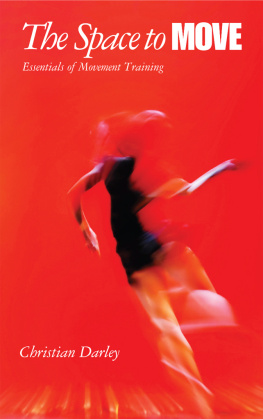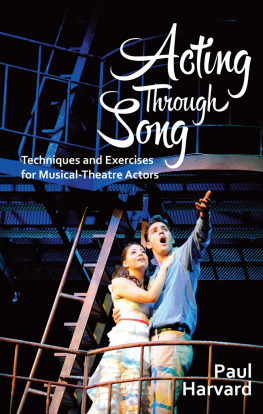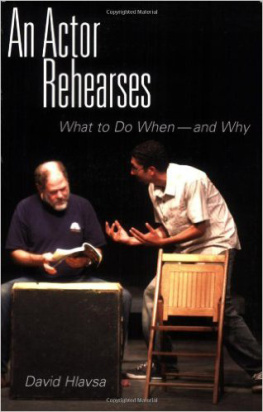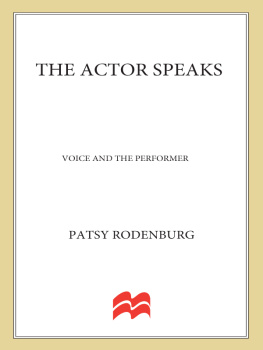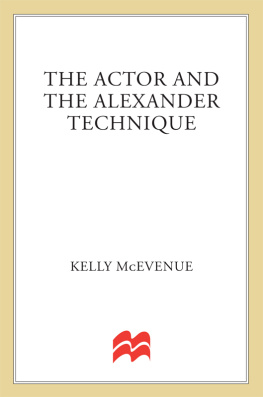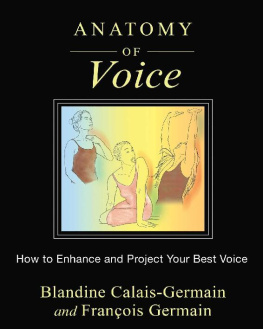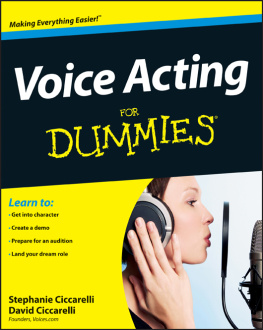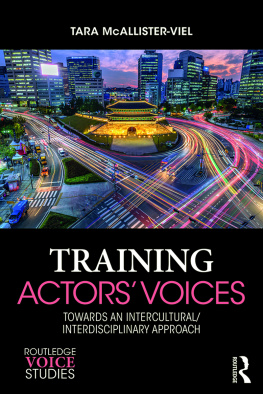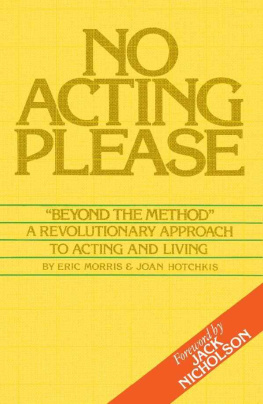Actor Training
The Laban Way
Actor Training
The Laban Way
An Integrated Approach to
Voice, Speech, and Movement
Barbara Adrian
Illustrations by Chelsea Clarke
2008 Barbara Adrian
All rights reserved. Copyright under Berne Copyright Convention, Universal Copyright Convention, and Pan-American Copyright Convention. No part of this book may be reproduced, stored in a retrieval system, or transmitted in any form, or by any means, electronic, mechanical, photocopying, recording, or otherwise, without prior permission of the publisher.
12 11 10 09 08 5 4 3 2 1
Published by Allworth Press
An imprint of Allworth Communications, Inc.
10 East 23rd Street, New York, NY 10010
Illustrations by Chelsea Clarke
Cover design by Derek Bacchus
Interior design by Kristina Critchlow
Page composition/typography by Kristina Critchlow
Cover photo by Scott Nangle
Models: Lindsey Liberatore and Jowan Thomas
Library of Congress Cataloging-in-Publication Data:
Adrian, Barbara.
Actor training the Laban way: an integrated approach to voice, speech, and movement/Barbara Adrian;
illustrations by Chelsea Clarke.
p. cm.
Includes bibliographical references and index.
ISBN-13: 978-1-58115-648-5
ISBN-10: 1-58115-648-0
eBook ISBN: 978-1-58115-748-2
1. Movement (Acting) 2. Voice culture. I. Title.
PN2071.M6A37 2008
792.028--dc22
TABLE OF CONTENTS
A song for my father and mother
ACKNOWLEDGEMENTS
W ithout the students who ventured into my studio, there could not be a book. In many ways, the students at Marymount Manhattan College have been my collaborators. Always openhearted and ready to experiment, they continue to inspire me to grow this process. The value of their feedback over the past years has been invaluable to the development of this integrated approach to voice, speech, and movement training.
I also wish to thank Marymount Manhattan College faculty and administration for their continuous support. The award of three Sokol Grants supported me in earning my CMA in Laban Movement Analysis and helped defray the cost of the illustrations for this book. Thank you to my department chair, Dr. Mary Fleisher, who from the word go encouraged and supported me with appropriate class time to develop this integrated approach.
I am particularly grateful for the artistic talents and generosity of Chelsea Clarke, who made an immeasurable contribution by creating all the illustrations for this book. Over the past two and a half years, Chelsea has been dedicated to getting it just right, and she did.
I was touched by and remain thankful to all who volunteered to read this book and offer their particular expertise during various stages of the writing. Thank you to Cheryl Clark, CMA; Kate Devore, MA, CCC-SLP; Ellen Goldman, CMA; and my colleagues at Marymount Manhattan College, Ellen Orenstein and Haila Strauss. Each of these individuals has specialized knowledge relative to voice, speech, and/or movement. Their experience in performance and training actors proved essential to a successful completion of this book.
Over the past thirty years, there have been many teachers who have influenced my work, but none more than the instructors from my certification program at the Laban/Bartenieff Institute of Movement Studies: Janis Pforsich OTR, CMA; Charlotte Wile, CMA; and Aliza Shapiro, CMA. Though he is no longer with us, I wish to acknowledge Raphael Kelly, who gave me my foundation in voice and speech training and encouraged me to teach.
Thank you to Ramona Tarkington-Deal who read every page more than once for clarity. Ramona does not make her living in the theatre; therefore, her feedback and editorial suggestions were priceless for making the content accessible to a wide range of readers.
Finally, for his profound knowledge of the human body and how it moves, and for his unflagging moral support, a special thank-you to my husband, Richard Sabel, MA, MPH, OTR, GCFP.
INTRODUCTION
My Journey
This is an age during which we are encouraged to learn more and more about less and less. Consequently, it is de rigueur to compartmentalize all manner of expertise. Regardless of your field of endeavor, after you have studied the basics, you are encouraged to pick a specialty. While this makes some legitimate sense in fields such as medicine, it has always seemed an artificial approach, particularly when applied to theatre training, and most specifically to voice, speech, and movement. That is because this triumvirate comprises the pillars that support the actors craft of storytelling. Take any one of them away and it all comes tumbling down. As one might imagine, the approach described in this book is based on my experience as a student, performer, and teacher.
When I was an undergraduate student earning her BA in theatre, voice training was exclusively the domain of singing lessons. Likewise, the movement curriculum was modeled almost entirely on dance classes. In speech classes, we sedentarily drilled on diction exercises that tended to result in the talking-head syndrome. Nice diction, but no connection from the neck down.
While singing, dancing, and diction lessons are important disciplines, many students find the studies intimidating. Student actors can become inhibited as they strive to sing the correct notes, reproduce the exact choreography, or standardize their pronunciation. The concern about being right can create disconnection between the actor and his instrument, which prevents the actor from moving and speaking on impulse, one of the hallmarks of an excellent actor. I define acting on impulse as mastery of whole-body responsiveness to stimuli moment to moment. In this light, it is easy to understand how the potentially exacting natures of the three pillars could be alienating. And when you combine their prescriptive natures with the fact that they are compartmentalized from each other, it becomes clear how the trainings could ultimately fail to support the actors toward the goal of acting on impulse.
At this moment, it may be useful to take a brief historical look at voice, speech, and movement training. In the sixties, seventies, and eighties, exciting models for voice training that moved away from traditional singing classes were developed by individuals such as Catherine Fitzmaurice, Roy Hart, Arthur Lessac, and Kristin Linklater. These individuals also recognized the importance of the whole body in the production of sound and each of their systems includes some movement training as well. While Fitzmaurice, Hart, and Linklater concentrated mostly on voice, Lessac developed some innovative approaches to diction. There can hardly be a student of performance dating from the 1960s to present times that hasnt been touched directly or indirectly by the processes developed by these individuals. In recent times, relative to articulation and pronunciation, Dudley Knights Detail Model provides the tools for describing and producing dialects of English as opposed to learning a correct or standardized way to speak English. This is in direct contrast to the teachings of Edith Skinner, who was a diction teacher from the 1940s until her death in 1981. Skinner valued standardizing pronunciation, and her book, Speak with Distinction (first published in 1942 and revised several times), remains a popular text.
Before and during the time that Fitzmaurice, Hart, Lessac, and Linklater were developing their experiments with voice, a few unconventional acting systems integrated voice with extreme physicality. The ultradisciplined trainings initiated by Jerzy Grotowski, Vsevolod Meyerhold, Eugenio Barba, and Tadashi Suzuki all developed the use of voice as part of their movement vocabulary. But since philosophically these trainings do not support the American dedication to traditional naturalism, they can often be relegated to special-topic classes.
Next page

